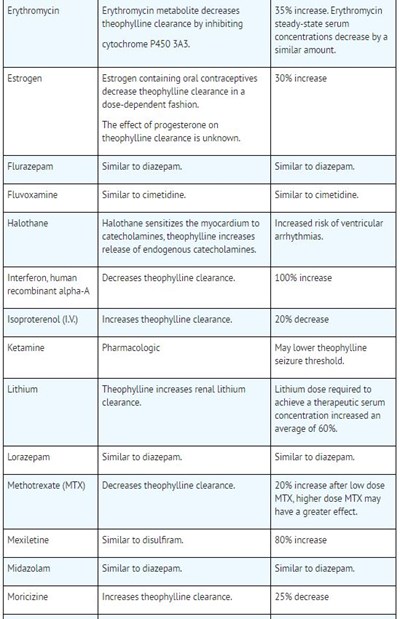Product Images Aminophylline
View Photos of Packaging, Labels & Appearance
Product Label Images
The following 14 images provide visual information about the product associated with Aminophylline NDC 0404-9813 by Henry Schein, Inc., such as packaging, labeling, and the appearance of the drug itself. This resource could be helpful for medical professionals, pharmacists, and patients seeking to verify medication information and ensure they have the correct product.
Image10.jpg - Image10

This is a table providing the initial theophylline infusion rates for different patient populations based on age and health status. The rates vary from 1 mg/kg/h for neonates up to 24 days to 0.21 mg/kg/h for infants, and decreasing from young children to elderly patients with cardiac or liver dysfunction, sepsis, or shock. The table notes that lower initial dosages may be required for patients receiving other drugs that decrease the clearing of theophylline. Additionally, the table provides target concentrations for aminophylline and neonatal apnea, as well as dosage limits based on serum levels. Ideal body weight should be used for obese patients.*
Image11.jpg - Image11

This text provides guidelines for making dosage adjustments to theophylline medication based on measured serum concentrations. It suggests dosage increments or decrements based on the value of peak serum concentration of the medication. The text provides clear dosage adjustment recommendations for a range of serum concentration values. Overall, this text appears to be a medical reference guide for clinicians who are treating patients with theophylline medication.*
Image12.jpg - Image12

This is a description of two different medication products, both packaged in 25-unit cartons with two different strengths. The first one has a total volume of 10mL and a total strength of 250mg, with a concentration of 25mg per mL. The second one has a total volume of 20mL and a total strength of 500mg, with a concentration of 25mg per mL. The products are identified by their unique National Drug Code (NDC) numbers.*
Image2.jpg - Image2

This text is discussing various medical conditions and their associated numerical values, such as pulmonary edema, COPD, cystic bronchiectasis, liver disease, cholestasis, pregnancy, sepsis, and thyroid disease. It also mentions how different populations may have differing rates of elimination and dosage requirements for theophylline. There is also a note that clearance may decrease at higher serum concentrations. Overall, this text appears to be a compilation of medical data rather than a useful description, and as such, may be difficult to interpret without further context or analysis.*
Image4.jpg - Image4

This text provides information on how different drugs affect the clearance of theophylline, a medication used in the treatment of respiratory conditions such as asthma and chronic obstructive pulmonary disease (COPD). The text includes information on specific drugs such as erythromycin, estrogen-containing oral contraceptives, and halothane, and how they can either increase or decrease the clearance of theophylline from the body. The text also includes a warning about the use of ketamine and its potential to lower the seizure threshold. Overall, the text provides valuable information for healthcare professionals who want to ensure that their patients are receiving safe and effective treatment for respiratory conditions.*
Image5.jpg - Image5

This document lists the effects of various drugs on the clearance of theophylline, a medication used to treat respiratory conditions. The drugs listed include pentoxifylline, phenobarbital, phenytoin, propafenone, propranolol, rifampin, sulfinpyrazone, tacrine, thibendazole, ticlopidine, troleandomycin, and verapamil. The text provides percentage increases or decreases in theophylline clearance caused by each drug and details on how each drug interacts with theophylline.*
Image6.jpg - Image6

This text is a warning label for a medication. It recommends consulting the precautions and drug interactions sections for more details on the medication. Additionally, the label lists the average effect the medication may have on a patient's theophylline concentration and notes that individual patients may experience greater changes.*
Image7.jpg - Image7

This is a table of drugs that have been found to not interact or produce clinically significant interactions with theophylline, a drug used to treat respiratory issues such as asthma and chronic obstructive pulmonary disease (COPD). The table lists several drugs, including albuterol, amoxicillin, atenolol, caffeine, and prednisone. It is advisable to refer to the "Precautions, Drug Interactions" section for more information regarding the list.*
Image8.jpg - Image8

This table shows the percentage of patients who experienced various symptoms of theophylline toxicity due to acute or chronic overdose, based on two different studies. Symptoms include vomiting, abdominal pain, diarrhea, hypokalemia, hyperglycemia, cardiac issues such as sinus tachycardia and atrial fibrillation, and others.*
Image9.jpg - Image9

This text describes various manifestations of theophylline toxicity in patients, including ventricular arrhythmias with hemodynamic instability, hypotension, shock, nervousness, tremors, disorientation, seizures, and death. The data is derived from two studies that focused on patients with serum theophylline concentrations greater than 30 meg/mL. The incidence of toxicity manifestations varied between the two studies, possibly due to differences in sample selection and reporting methods. Some data was not reported in a comparable manner.*
Label1.jpg - Label1

Aminophylline is a medication that is delivered in the form of a 250mg/10ml injection. It is a single-use vial that should be protected from light and should not be used if crystals have separated from the solution. It is meant to be used intravenously and only if the solution is clear and the seal is not damaged. It does not contain a bacteriostat and should be used promptly. Any unused portion should be discarded using aseptic technique. The medication is sterile and nonpyrogenic and should be kept out of reach of children and stored at a temperature of 68F to 77F. The package is produced by Henry Schein, Inc and has a unique product code and other information for prescribing and tracking purposes.*
* The product label images have been analyzed using a combination of traditional computing and machine learning techniques. It should be noted that the descriptions provided may not be entirely accurate as they are experimental in nature. Use the information in this page at your own discretion and risk.


